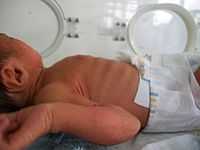Labored breathing
Labored respiration or labored breathing is an abnormal respiration characterized by evidence of increased effort to breathe, including the use of accessory muscles of respiration, stridor, grunting, or nasal flaring.[2]
Classification
Labored breathing is distinguished from shortness of breath or dyspnea, which is the sensation of respiratory distress rather than a physical presentation.
Still, many[3] simply define dyspnea as difficulty in breathing without further specification, which may confuse it with e.g. labored breathing or tachypnea (rapid breathing).[4] Labored breathing has occasionally been included in the definition of dyspnea as well.[5] However, in the standard definition, these related signs may be present at the same time, but don't necessarily have to be. For instance, in respiratory arrest by a primary failure in respiratory muscles the patient, if conscious, may experience dyspnea, yet without having any labored breathing or tachypnea. The other way around, labored breathing or tachypnea can voluntarily be performed even when there is no dyspnea.
Presentations

Presentations of labored respiration include:
- Hyperpnea - faster and/or deeper breathing
- Tachypnea - increased breathing rate
- Retractions or recessions - sucking in of the skin, around the ribs[1] and the top of the sternum[6]
- Use of accessory muscles of respiration rather than only the diaphragm
Causes
Causes of labored breathing include:
- Severe metabolic acidosis, particularly diabetic ketoacidosis (DKA) but also renal failure. The specific associated breathing pattern is called Kussmaul breathing.
- Cardiac disease[7]
- Respiratory failure[7]
See also
- List of terms of lung size and activity
- Agonal respiration, a specific type of abnormal breathing pattern
References
- ↑ 1.0 1.1 Levene, Malcolm I.; David Ian Tudehope,Michael John Thearle (2000). Essentials of neonatal medicine. Wiley-Blackwell. p. 28. ISBN 0-632-05163-9.
- ↑ TheFreeDictionary > labored breathing Retrieved on Dec 12, 2009
- ↑ TheFreeDictionary, retrieved on Dec 12, 2009. Citing:
- The American Heritage Dictionary of the English Language, Fourth Edition by Houghton Mifflin Company. Updated in 2009.
- Ologies & -Isms. The Gale Group 2008
- ↑ West JB (2008). Pulmonary pathophysiology: the essentials (7 ed.). Baltimore: Lippincott Williams & Wilkins. p. 45.
- ↑ Definition of Dyspnea MedicineNet. Last Editorial Review: 11/1/1998]
- ↑ UpToDate >Patient information: Croup in infants and children Charles R Woods, MD, MS. Last literature review version 17.3: September 2009
- ↑ 7.0 7.1 Medilexicon Medical Dictionary - 'Labored Respiration' Retrieved on Dec 12, 2009